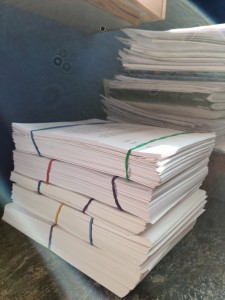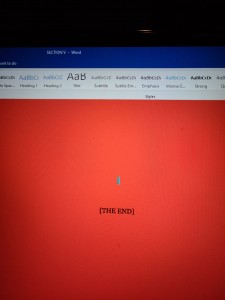Important Update: Just a few weeks after I posted this blog entry below, a publication date of November 23, 2021, was announced for GO TELL THE BEES THAT I AM GONE by my publisher, Penguin Random House.
Please read my newer blog entry about the publication date announcement, or visit my BEES webpage for current information about this new book.
 I’ve finished writing GO TELL THE BEES THAT I AM GONE, as of March 27, 2021! Now this new book enters the publication process, outlined below, which will likely take months (a guesstimate only).
I’ve finished writing GO TELL THE BEES THAT I AM GONE, as of March 27, 2021! Now this new book enters the publication process, outlined below, which will likely take months (a guesstimate only).
Please keep in mind that I do not set the publication date, the day when you can buy the book at a bookstore. That date will be decided by my publishers. Stay tuned!
Thanks!
What Finished Means To An Author
As my husband often remarks, "‘FINISHED’ is a relative term to a writer."
This is true! <g> I thought y’all might be interested in Just What Happens to a book after the writer is “finished” writing the manuscript:
(NB: This is the Standard Operating Procedure (SOP). Owing to the tight Production schedule—such as there was for MOBY (Book 8) and THE OUTLANDISH COMPANION, Volume 2—a lot of these steps have been done concurrently, rather than sequentially, and a few repetitive steps have been skipped. But by and large, this is how it works.)
- Books don’t go directly from the author to the bookstore.
- Books go from the author to the editor, who
- reads the manuscript
- discusses the manuscript with the author, and
- suggests minor (we hope) revisions that may improve the book
-
The book goes back to the author, who
- re-reads the manuscript
- considers the editor’s comments, and
- makes whatever revisions, emendments, or clarifications seem right.
-
The book goes back to the editor, who
- reads it again
- asks any questions that seem necessary, and
- Sends it to
-
The copy-editor. This is a person whose thankless job is to
- read the manuscript one…word…at…a…time
- find typos or errors in grammar, punctuation, or continuity (one heck of a job, considering the size not only of the individual books, but of the overall series), and
- apply “house style” to things like numbers (e.g. do we write “two” or “2”?), and
- write queries to the author regarding anything questionable, whereupon
-
The book comes back to the author—yes, again— who
- re-reads the manuscript
- answers the copy-editor’s queries, and
- alters anything that the copy-editor has changed that the author disagrees with, and
- adds things inspired by the copy-editor’s comments that seem like a good idea. After which, the author sends it back to
-
The editor—yes, again!—who
- re-re-reads it
- checks that all the copy-editor’s queries have been answered, and sends it to
- The Typesetter (aka Compositor, these days), who sets the manuscript in type, according to the format laid out by
-
The Book-Designer, who
- decides on the layout of the pages (margins, gutters, headers or footers, page-number placement)
- chooses a suitable and attractive typeface
- decides on the size of the font, leading and kerning
- chooses or commissions any incidental artwork (endpapers, maps, dingbats—these are the little gizmos that divide chunks of text, but that aren’t chapter or section headings)—or, for something like the OC II, a ton of miscellaneous illustrations, photographs, etc. that decorate or punctuate the text.
- Designs chapter and Section headings, with artwork, and consults with the
(NB: People always want to know how many pages the book will be. This depends entirely on the Book Designer’s decisions, so there’s no telling ahead of time. The font, leading, kerning (leading and kerning are, respectively, the amount of space between lines and between letters) and page layout will all affect how many words fit on a page.)
- Cover Artist, who (reasonably enough) designs or draws or paints or PhotoShops the cover art (this often happens earlier in the process, but I put it here for convenience), which is then sent to
- The Printer, who prints the dust-jackets—which include not only the cover art and the author’s photograph and bio, but also "flap copy," which may be written by either the editor or the author (I usually write my own), but is then usually messed about with by
-
The Marketing Department, whose thankless task is to try to figure out how best to sell a book that can’t reasonably be described in terms of any known genre <g>, to which end, they
- try to provide seductive and appealing cover copy to the book (which the author normally approves. I usually insist on writing it myself).
- compose advertisements for the book (author usually sees and approves these—or at least I normally do).
- decide where such advertisements might be most effective (periodicals, newspapers, book-review sections, radio, TV, Facebook, Web)
- try to think up novel and entertaining means of promotion, such as having the author appear on a cooking show to demonstrate recipes for unusual foods mentioned in the book.
- kill a pigeon in Times Square and examine the entrails in order to determine the most advantageous publishing date for the book.
-
OK. The manuscript itself comes back from the typesetter, is looked at (again) by the editor, and sent back to the author (again!), who anxiously proof-reads the galleys (these are the typeset sheets of the book; they look just like the printed book’s pages, but are not bound. (NB: of recent years, galleys are often provided in electronic form)), because this is the very last chance to change anything. Meanwhile
(Somewhere in here, recording begins on the audiobook, which is normally released at the same time as the hardcover. Ideally, the narrator is given a version of the manuscript that’s pretty close to the ultimate printed form, but they may get earlier or partial versions from which to prepare their performance (choosing accents and pacing for different characters, for instance).)
- A number of copies of the galley-proofs are bound—in very cheap plain covers—and sent to (NB: This is SOP, but we haven’t been doing it for the last few books, owing to the fact that the book itself is coming out on the heels of Production; there’s no time to distribute ARCs (Advanced Reading Copies).) (NB: These days, it’s often PDFs, though paper ARCs are still used, too.))
- The Reviewers, i.e., the bound galleys (or PDFs) are sent (by the marketing people, the editor, and/or the author) to the book editors of all major newspapers and periodicals, blogs, websites, and to any specialty publication to whom this book might possibly appeal, in hopes of getting preliminary reviews, from which cover quotes can be culled, and/or drumming up name recognition and excitement prior to publication. Frankly, they don’t always bother with this step with my books, because they are in a rush to get them into the bookstores, and it takes several months’ lead-time to get reviews sufficiently prior to publication that they can be quoted on the cover.
-
With luck, the author finds 99.99% of all errors in the galleys (you’re never going to find all of them; the process is asymptotic—vide the typo in the very last line of MOBY…), and returns the corrected manuscript (for the last time, [pant, puff, gasp, wheeze]) to the editor, who sends it to
(The ebook coding happens somewhere in here.)
- The Printer, who prints lots of copies (“the print-run” means how many copies) of the “guts” of the book—the actual inside text—are printed. These are then shipped to
- The Bindery, where the guts are bound into their covers, equipped with dust-jackets, and shipped to
-
The Distributors. There are a number of companies—Amazon is the largest, but there are a number of smaller ones, and the large publishing houses have their own warehouse facilities, too—whose business is shipping, distributing, and warehousing books. The publisher also ships directly to
(1. Arrangements are made in this phase for ebook distribution through retailers like Amazon and Barnes & Noble.)
- Bookstores, but bookstores can only house a limited number of books. Therefore, they draw on distributors’ warehouses to resupply a title that’s selling briskly, because it takes much longer to order directly from the publisher. And at this point, [sigh]… the book finally reaches
- You, the reader.
And we do hope you like it when you get it—because we sure-God went to a lot of trouble to make it for you. <g>
Click here to visit my Writer’s Corner (What I Do) webpage…
Images are by Diana Gabaldon. The top image shows printed book manuscripts. The bottom image shows a screen from her word processing software.
This blog post includes an updated version of “What Finished Means To An Author,” an essay that I have posted several times in the past. This new version was also posted on my official Facebook page on Monday, March 29, 2021.

My wife was excited to get the book. But she found typos in the first paragraph and on the second page. Is it supposed to read painter and not panther?
Hi,
“Painter” is a local word for “panther” in parts of the American south. So these are not typos.
Enjoy BEES!
Diana’s Webmistress (Loretta)
I loved all of the books, plus they are all in paperback. I was wondering when Bees was going to come out in paperback so I can keep the series all the same.
Thank you
Hi, Melissa,
Paperback editions of bestselling novels come out some time after the hardcover first editions. Maybe a year or so in most cases. That is up to the publisher for the country you live in.
No release date has been announced for BEES in paperback yet by Penguin Random House, her publisher in the U.S.A. When it is, the information will be posted on Diana’s official website, her official Facebook and Twitter accounts, and on the publisher’s website. International editions are released according to the publisher in each country.
Thanks,
Loretta
Diana’s Webmistress
Is Bees the final Outlander book? I thought I saw an interview where Diana said it would be the last book and would explain the “ghost of Jamie?” In the first novel?
Thank you
Hi, Judy,
No, as stated on Diana’s website, BEES is not the last book featuring Jamie and Claire. Book Ten is next, which at present doesn’t have a title.
Lots of great info on her webpages if you decide to dive into them.
Hi, Judy,
As stated elsewhere, I am working on the tenth book in my Outlander series of major novels. As of now, it will likely be the last book to feature the story of Jamie and Claire. Excerpts of this book will be posted on my official Book Ten (as yet untitled) at:
http://www.dianagabaldon.com/books/outlander-series/book-ten-no-title-yet/
Diana
I was sorry when I came to the end of Bees☹️
Is there any estimate when book 10 will be released?
I just re-read Fugitive Green, will there be more Hal and Minnie?
Thank you for all the books!
I am reading this timeline and howling with laughter, especially at the regrettable (but clearly necessary) death of a pigeon in exchange for the publishing date. A noble sacrifice.